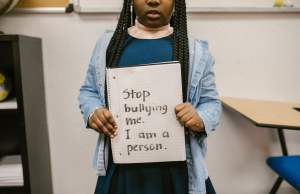- Our friends are some of the last people we’d expect to bully us or mistreat us in anyway, but it happens and it’s important to know what that looks like.
- While disagreeing and hurting each other’s feelings every now and then is normal, it is not normal nor okay for a friend to bully—tease, control, manipulate.
- If your friend is bullying you, it’s important that you bring attention to the issue immediately: first, explain to your friend exactly what they’re doing that is hurtful.
- Once you shed a light on their bullying behavior, tell your friend how their mistreatment makes you feel: are you hurt, or angry, or sad? Be specific and don’t hold back.
- Finally, know when it’s time to call it quits on your friendship; if they don’t show any remorse or any sign of changing their bully behavior, it’s time to let that “friend” go.
The last people we expect to bully us are our friends, but the sad truth is that it happens. And because they’re our friends—our trusted loved ones—it can be difficult to recognize the mistreatment. That said, it’s important we do understand what it looks like when our friendships take a turn for the worst and what actions to take next.
Understanding the Ebbs and Flows of Friendship vs. Bullying
Dr. Tarra Bates-Duford, a forensic psychologist, explains that it’s normal to run into bumps in the road of your friendship, but bullying is a whole different ballgame: “It is normal in every friendship for ebbs and flows to exist. Friends will often get along great, but there will be times when good friends will fight. It is not uncommon in a friendship to argue, question the friendship, and resume the friendship. Friends will sometimes hurt each other’s feelings, have an argument, or simply need time away from one another.” Now, the following signify you are actually being bullied by your friend, according to Dr. Tarra:
- Your friend makes fun of you in front of others.
- He/she divulges and teases you about things disclosed in privacy.
- Your friend provides conditions on your friendship (e.g., “If you do this we are no longer friends”).
- You have told your friends to stop the negative comments or behavior because it hurts you and they continue anyway.
- Your friend mimics your way of speaking and behavior.
- You are told who you can be friends with and who you can’t.
- Your friend deliberately withholds social events from you (e.g., a party, a get-together, and so on).
- When you become emotional about some of the mean things a friend has done to you, they minimize or make fun of your feelings.
Putting an End to the Bully Behavior
If you’ve found yourself in a situation where your friend is mistreating you, there are a few actions you can take. Let’s start with these:
1) Bring attention to their behavior. First, shed a light on how they’ve been treating you. It’s possible they don’t realize what they’re doing is hurtful. So, highlight their bullying tendencies for them: Are they teasing you? Are they trying to control you? Are they gossiping about you? Be prepared to share examples.
2) Explain how it makes you feel. You can help your friend realize their actions are inappropriate and hurtful by simply telling them how they affect you. Again, be specific: Do you feel hurt? Are you disappointed? Are you sad? Angry? Whatever it is you’re feeling, share those emotions with your friend.
3) Know when it’s time to cut ties. Finally, cut your “friend” off if you need to. Sadly, putting an end to the bully behavior may mean putting an end to the friendship. “In these instances, my recommendation for handling it becomes black and white,” says Psychologist Sidney Cohen. “Bluntly challenge the so-called friend that if it continues, the friendship is over. And whether that ‘friend’ chooses to seek professional help or not, the person on the receiving end of this bullying must muster up all the courage they can to take a stand, and stick with it!”













